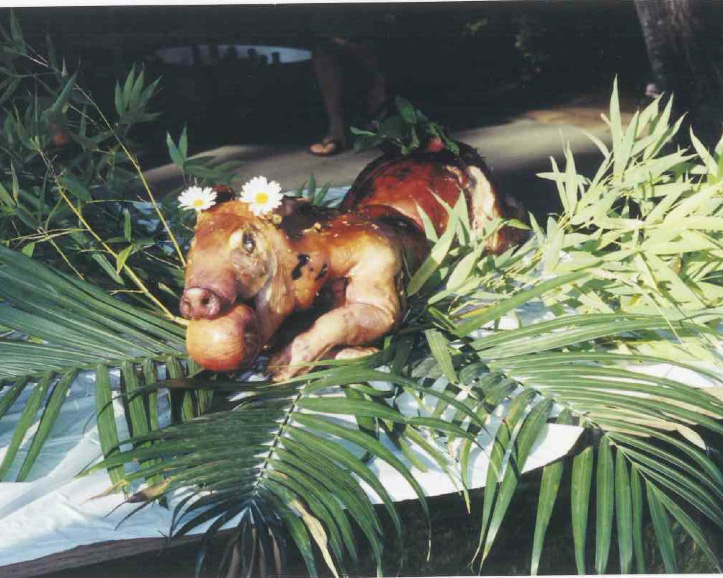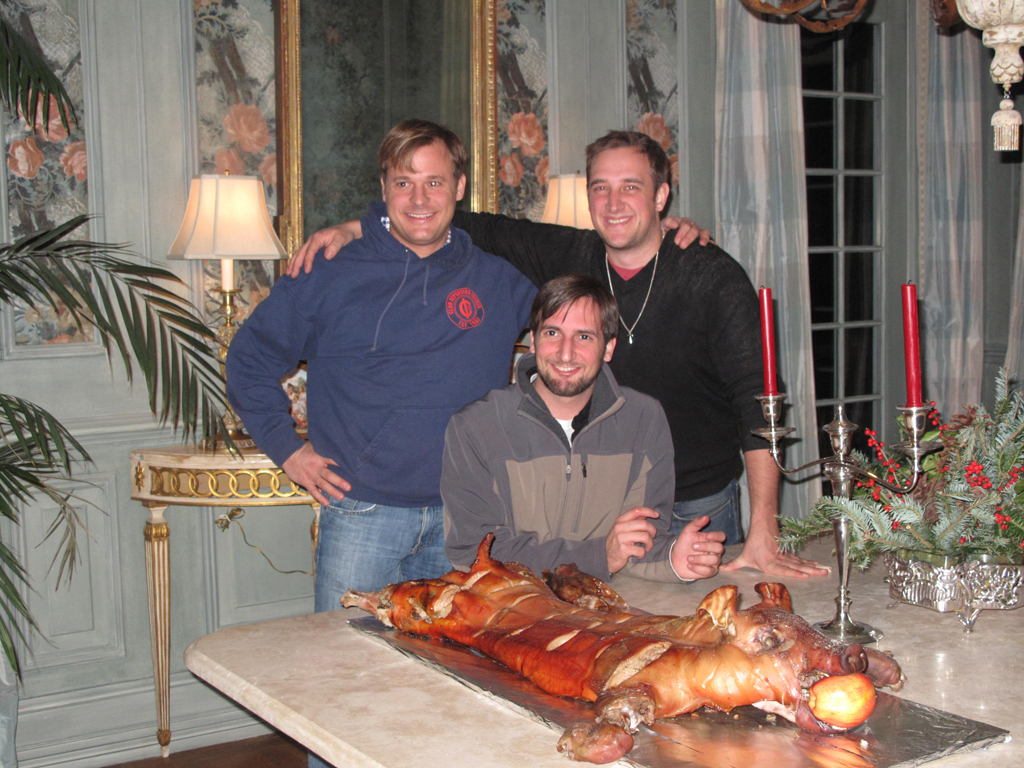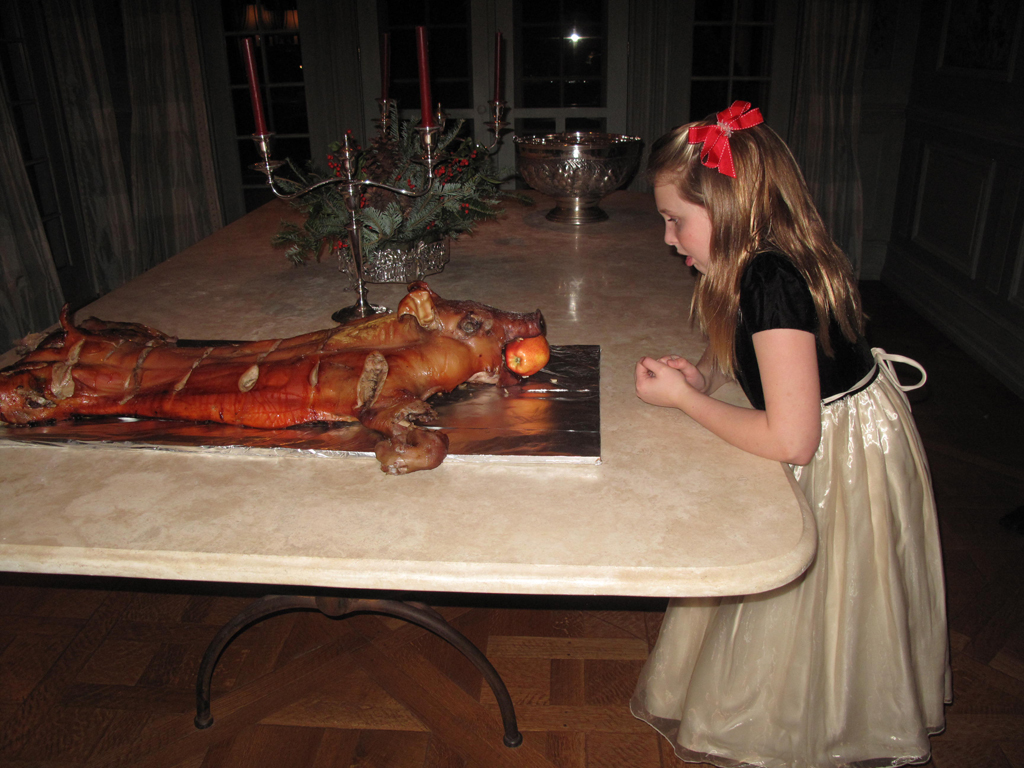It Takes A Family To Cook A Pig

I believe there have been pigs in our family’s history for generations. In fact, they have most likely been around for more than a century. I imagine that in the beginning there were many tropical ones, and from the stories I have heard, they were usually cooked by the town baker when our family lived in Cuba. I am sure there may have been some great stories and fun times with those tropical pigs, but it seems to me that the really funny things began to happen when our family left the tropics, moved North, and started its continuing relationship with the infamous northern pig. I must remind you that the greatest challenge here is the physics of roasting a whole animal (which is certainly an outdoor task) on the 24th of December, a day that historically comes with freezing temperatures. Although many of the great pigs happened before I was born or can remember, I have heard some unforgettable stories and experienced some as well.
One of the most famous must be the pig which was roasted in the basement of a house in Rochester NY. Alberto Martinez, my grandfather, who in all of my memories was the head pig chef, was an accomplished engineer and a very spirited man. Knowing him well, I am sure he could not be daunted by the blizzard and near arctic conditions that the snow belt city of Rochester had to offer that year. He and Emilito Pelaez, well known for his great planning and sound ideas, devised a plan of near-perfect engineering marvel to deliver yet another Christmas pig to the family. From my understanding, an elaborate system of vents and fans was constructed in the basement of the house so that a pig could be completely roasted over open flame indoors in comfort while the cold and snow raged outside. To everyone's delight it seemed to work, and as the hours passed and the laughter and celebration marched on the pig roasted slowly and the drinks flowed freely. Obviously this all seems too good to be true, and it was just that. I am sure that right in the middle of some singing and dancing and possibly even a little fighting, the cellar door burst open from the force of a boot. This boot belonged to the lead man of the City of Rochester fire department, who rushed in, grabbed the pig and anything else that was cooking or burning down there, ran it immediately outside, and tossed the lot into the snow. I can only imagine the look of panic, then shock, then remorse on the faces of all those drunken Cubans as their Christmas pig, just moments before a golden roasting triumph, sat smoldering in the snow. When the shouting stopped and reason prevailed, the cause of the problem became evident. Apparently, the house had a laundry chute which had escaped our resident engineer’s calculations. It acted like a chimney and drew all the pig smoke from the basement upwards and filled the upstairs rooms with billowing smoke. The neighbors, seeing this, had called the fire department in an honest attempt to save the poor Martinez family home from destruction.
My own memories of roasting pigs begin in our greenhouse on Conover Lane in Rumson NJ. My parents, grandparents Alberto and Haydee, my great aunt Magali, and my Aunt Joanna and Uncle Wilfredo had all contributed money to buy a small compound which consisted of a main house, a carriage house, a tool house, and what I believe was an original Lord and Burnham wood and iron greenhouse. The tool house was lifted singlehandedly by an amazing nearly 90 year old black man working with the assistance of four small pump jacks and a tractor trailer. He then moved the tool house next to the main house and Magi’s (Magali’s) annex was born.
I remember many pigs being cooked in that greenhouse accompanied by singing and dancing, laughter and drinking, fighting and hugging, and of course many spray bottles of water to put out the grease fires that continually erupted beneath the roasting pig. As usual, my grandfather Alberto was the man in charge of the cooking. His method for roasting was very simple and, except for the grease fires, very effective. He started with making a rectangular bed in the ground slightly wider and longer than the pig when laid out flat. This bed was filled with charcoal but he was always careful to keep the coal concentrated in the front and back and very little in the center where there would be little meat to cook. At each corner was a stack of about 4 bricks that acted as supports for the grill. The grill was made of 2 identical pieces which resembled the stretchers one would use to carry wounded off a battle field except that they were made entirely from metal and had cross pieces at each long end to prevent the center from sagging. There were two long steel poles running the length, joined by two short poles set in from the ends leaving the remainder of the long poles as handles. The center was spanned by a metal mesh that was welded to the poles. So the pig would lie there belly-down and spread-eagle roasting for the better part of a day and night. The further into the process we got the more frequently the grease fires erupted and had to be put out. There was also constant discussion about the proximity of the pigs to the coals. The height of the bricks was repeatedly adjusted by one family member only to be readjusted by someone else later. The final touch to this method was certainly the most dramatic and always involved the assistance, coaching, and cheering from the rest of the family. The second stretcher, which until now had gone unused, was placed on top of the pig and the handles on the top stretcher were held tight to the handles of the bottom stretcher. Then, in one swift motion, the stretchers were lifted from the fire and turned one over the other flipping the pig for his final stage of roasting belly-up above the coals. This was done to crisp all the skin on his back which, for the most part, is for presentation, but is also eaten by some once it is crispy enough. I personally cooked several pigs this way, and even had stainless steel stretchers made for the task. I believe they are still resting quietly in Southampton waiting to be called to use some day in the future.
Yet another method we have employed in our attempts at a perfect Christmas pig was the rotisserie. First employed in Mill Valley, California on Sky Road, we had a pig to celebrate my grandmother Haydee’s Birthday, or Mothers Day, or something like that, and gathered the family on a beautiful spring day in May. A large pig was strapped to the rotisserie and suspended above what looks like an oil drum that was cut in half long ways and set on its side. The bottom half gets the coal, and the top half is hinged and acts as a cover. The pig simply spins around and around and cooks very evenly for many hours until done. The grease fires still erupted and we had problems from keeping his dangling feet out of the fire. For the most part, it was a very successful pig and enjoyed by all. That one in particular had a near perfect presentation complete with a palm frond bed, daisy earrings, and a perfect apple in his mouth. The single most important factor with this pig was the timing of the event, which was May. Roasting a pig in mild weather is a breeze compared to the attempts in the cold and this lesson could not have been better proven than with the second rotisserie pig which also took place at Sky Road.
This time we were attempting a Christmas pig and, by tradition, the cooking of this pig was taking place on December 24th. By Northeast standards it was not cold. I believe we had mid 50’s in the day and low 40’s during the night. Unfortunately, these temperatures were accompanied by a good 20 knot wind. The pig, which was 70 pounds this time and being prepared for around 40 guests, was started early in the morning and was being timed for a 9 PM serving. All seemed well throughout the day, and I struggled with the normal grease fires, and the dangling legs hitting the coals, but as night fell I started to worry that it just didn’t seem to be advancing enough. After careful consideration and the advice of at least 40 family members and friends, it was decided that it was too cold and too windy. The heat was blowing away before it got to the pig. Action was taken. The entire rotisserie was moved to a nook behind the house and a wind shield of plywood was crudely constructed. At this point it should have been problem solved and a return to the waiting game. The party continued with everyone singing and dancing (although not as much singing as I remember in the old days), drinking and laughing, and the occasional bit of fighting and hugging. That night was exceptionally fun because we had been making mojitos for everyone there (except Magali because she only drinks them in the morning) and, as you know, they can be quite strong. By the time 9PM rolled around everyone was feeling very good, and asked if we could start serving the dinner. Unfortunately, my pig was not done and I asked for one more hour. At 10 PM they returned feeling even better, and once again I had to say that the pig was still not quite ready and I needed another hour. Thanks to good mojitos, excellent spirits, and perhaps a Christmas miracle when they returned at 11 PM to hear that I needed yet another hour, they accepted it and did not throw me in the rotisserie on the spot! At 12 Midnight, I unveiled for all to see one completely beautiful pig, which was 100 percent raw on the inside. At this point everyone was completely drunk having been drinking on empty stomachs all night. In my mind, Christmas was pretty much ruined. Then when I least expected it, my Christmas miracle did arrive in the form of two whole pig legs which Bobby had put in the oven hours earlier as a safety net for all of us when he started to doubt the outcome of this very large and long overdue Christmas pig. Eventually everyone had enough to eat, certainly plenty to drink, and finished the Noche Buena smiling and content. Christmas morning that year started with Maria sampling some of the pig’s meat, now rancid from sitting indoors all night, and Magali proceeding to cut off its head to bring it home for a special soup she enjoys after Christmas every year. Fortunately, they both survived. Many lessons were learned that year, but the most important was the questionable feasibility of actually cooking a pig outdoors in cold weather without the protection of a greenhouse. I was beginning to believe that it might be impossible.
My mother, Antonia, stepped in with a little bit of internet searching and a genuine desire to solve the problem which threatened to single handedly drive an age old cultural and family tradition into extinction. Apparently her relentless searching addressed the question of what so many other Cuban Americans who had fled North into the United States had done for their Noche Buenas. How could it be possible that a people as clever and resourceful as Cubans could possibly accept defeat against the odds of cold northern winters? This question was answered and the problem that all Cuban exiles faced was finally solved. Mom traveled to Miami to meet Roberto Guerra, a Miami Cuban, and he and his dad explained how they invented the Caja China. This magical contraption is basically a metal-lined wooden box with a metal lid on top that doubles as a tray for coal. This ingenious design works with radiant heat from above, so the pig cooks safely below the coals in his lined wooden box and roasts in heat saturated with his own juices. The result is the most tender fall-off-the bone pork that is ready in 4 to 6 hours. The days of 10 plus hour pigs guarded by a slightly drunk chef and his numerous assistants armed with water pistols on their grease fire patrols were over. No more constant surveying of the coals, or the distance the pig was from them, or the state of legs dangling from rotisserie, or the studying of wind patterns and nighttime temperatures. In fact our only great task now is keeping the nosy Cubans, who almost always have been drinking a little, from opening up the box before it is time, because that is truly the only way to ruin a pig in a Caja China.
So, these have been my favorite few of the many, many pigs in our family's history, but I want to be clear that this is only about the cooking of the pig. The work actually starts long before Noche Buena with the search to find the perfect pig. Of the many pig quests, probably the best loved is the pig that arrived from Louisiana in Alberto’s suitcase. Of course, that was in the days before airport screening.
Before you get the impression that cooking pigs is men’s work we need to acknowledge the critical steps in the preparation of the pig. In this area the matriarchs of the family have always reigned supreme. My great Aunt Magi has captained this effort with all the pigs I have cooked to date, and seems to be passing her wisdom on to quite a few others. There is the preparation of a Mojo, dressing the pig with its marinade, careful placement and insertion of cloves of garlic throughout the meat, and many other techniques without which the pig would never reach its full state of perfection. Although I am not well versed in those stages and still quite the student in the cooking stage, I feel I have found a great understanding for the entire process. Cooking one single dish that is large enough to feed a huge family, doing it together as a group from preparation all the way to presentation, spending a whole day and a night having fun together leads eventually to the climax of sharing a truly delicious meal. This is what is so very good, so very important and something to be protected and passed from generation to generation.
Mark Viatori Martinez





